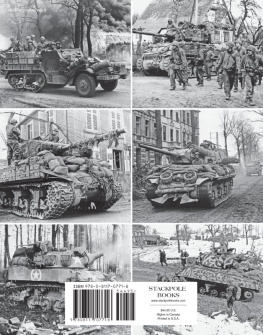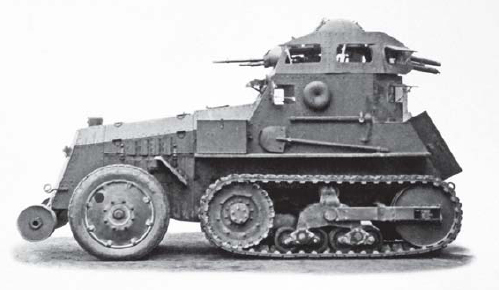NEW VANGUARD 213
FRENCH TANKS OF WORLD WAR II (2)
Cavalry Tanks and AFVs
| STEVEN J. ZALOGA | ILLUSTRATED BY IAN PALMER |
CONTENTS
FRENCH TANKS OF WORLD WAR II (2)
CAVALRY TANKS AND AFV S
EARLY EFFORTS AT CAVALRY MECHANIZATION
As was the case elsewhere in Western Europe, World War I was the swansong of traditional French horse cavalry. The cavalry continued to exist in the French army, but in a very diminished and distorted form. A number of cavalry divisions were still present in the order of battle, but they fought on foot and differed little from the ordinary infantry. After the war, the French army still saw a potential use for horse cavalry to conduct reconnaissance, flank security and liaison operations, but largely as a servant of the infantry. The idea of the cavalry as the mobile arm of decision on the battlefield was in serious doubt. A secondary reason for the retention of the cavalry was their value in the colonies, especially in North Africa and the Levant where they still had their utility.
The cavalry had dabbled in mechanization as early as 1902 in the form of armored cars. They were generally designated as automitrailleuses (AM: machine-gun cars) or auto canons (AC: gun cars) depending on their armament. They saw combat use in the mobile opening phase of the war, but became increasingly irrelevant with the stagnation of trench warfare. Early armored cars were based on conventional automobile chassis, and they were overburdened with armor, underpowered, and susceptible to becoming bogged down off the road. There was a brief flurry of use in the final year of the war with the arrival of improved designs and greater opportunities for mobile missions.
To their credit, senior French commanders saw cavalry as focused on a mission rather than defined by the horse. The most influential cavalry officer of the interwar period, Gn Maxime Weygand, wrote an influential article in the very first postwar issue of the Revue de Cavalerie in 1921. He argued that
trench warfare is the negation of war, since war always seeks a decision which can only be produced through movement ...The cavalry will keep its raison dtre as long as speed and surprise are valued on the battlefield ...The war of tomorrow will be, more than ever, a war of machines.
The more far-sighted cavalry leaders saw the esprit cavalier tied to mobility rather than to the horse. The French cavalry continued to develop the armored car, but recognized from the outset that it was road-bound. The standard practice was to form mixed scouting groups of armored cars and motorcycles, with the motorcycles used for cross-country scouting.
In the late 1920s, the French cavalry hoped that the half-track technology embodied in the Citron-Kgresse system would overcome the mobility problems of traditional armored cars. The most numerous type built was the AMC Schneider P16, which was manufactured in 193031. (MHI)
At the beginning of the 1930s, the cavalrys armored force in metropolitan France consisted of 11 squadrons of White TBC armored cars left over from World War I. Of the 230 armored cars still on hand, about half were modernized between 1931 and 1933 by rebuilding them on Laffly truck chassis with 50hp engines. These were called AMD Laffly 50 AM or White-Laffly.
The problem facing the French cavalry in the 1920s was the lack of funding and the weakness of the technology. Tanks were a possible solution, but they were too slow and the postwar reorganization put them under infantry control. In spite of this, the French cavalry units experimented with the use of mixed tank/armored car raiding groups. Renault FT tanks were carried piggyback on heavy trucks for speed and the tanks were disembarked when needed for combat missions. The moto-mobile groups of the early 1920s were an interesting precursor of the later mechanized divisions.
The Schneider P 16 remained in service through the 1940 campaign, although its role diminished as fully tracked cavalry tanks began to appear. This example is seen on duty with the 2e GAM during summer war games in the 1930s. (NARA)
The AMC Citron P 28 was an attempt to convert a failed infantry tractor into a cavalry armored car. Although 50 were ordered in 1931, they proved to be a technical flop and they were retired prior to the 1940 campaign. (NARA)
The panacea for the French cavalry in the 1920s was the half-track. This technology seemed to offer essential cross-country capability as well as superior speed to contemporary tanks. Most of the early experimental work focused on the Citron-Kgresse system. Adolphe Kgresse was born in France but emigrated to Russia in 1905, where he worked in the imperial auto park of the tsar. He developed a half-track system using rubberband tracks to improve the mobility of the tsars limousines while on hunting expeditions in the Russian countryside. In the wake of the Russian revolution, he returned to France in 1919 and was hired by Citron to adopt this suspension system to both commercial and military vehicles. Following a disastrous expedition in Algeria in 1920, when most of the 32 vehicles in a convoy into the Sahara were lost, Gn Jean-Baptiste Estienne proposed using Citron-Kgresse half-tracks. A convoy of five vehicles crossed the Sahara and reached Timbuktu in the winter of 192223. This led to several other expeditions around the globe that highlighted the remarkable cross-country value of the Citron-Kgresse system.
In light of the publicity attending the use of the Citron-Kgresse system, there were a number of experimental half-track AFVs built between 1922 and 1925. The only one to reach series production was the Citron P4T. It had a rear-mounted turret with a 37mm gun, and 14 were built. Some were sent to cavalry units in the Levant, but it proved to be too weakly powered. The more robust AMC (automitrailleuse de cavalerie) P16 was developed by 1928. This used an improved Citron-Kgresse suspension and a more powerful Panhard 60hp engine, providing a sustained road speed of 30km/h (18mph) though it could be pushed to 47km/h (29mph) for short periods. The first four pilots were assembled by Schneider on Citron chassis starting in 1928. After some refinements, the French cavalry placed an order for 96 vehicles in 1930, with deliveries complete by 1931.
In the meantime, Citron proposed its own half-track AMC. This was based on its experimental infantry resupply vehicle Type N, a losing competitor to the Renault UE. The resulting AMC Citron P28 was an attractive design with a center-mounted turret. The cavalry ordered 50 in October 1931. However, they proved to be an extreme disappointment in all respects. A total of 44 remained in French cavalry service for instruction, and three were exported to Uruguay. The half-track AMC proved to be a technological dead end for the French cavalry. As Gn Weygand noted during the September 1932 war games, the AMC that were conceived of a decade ago are obsolete from the moment they leave the factory. Although they offered better cross-country mobility than the old White armored cars, they were far from satisfactory.




















